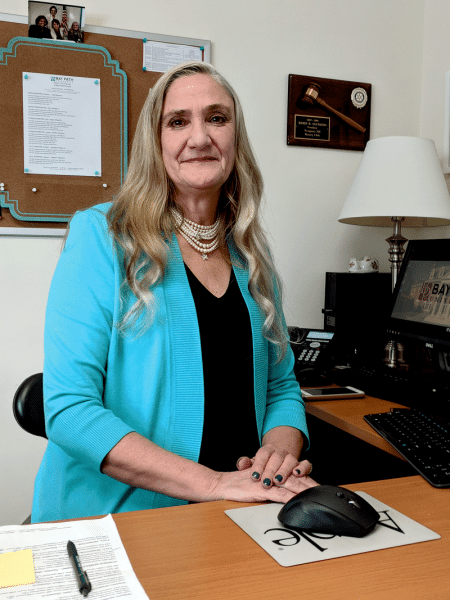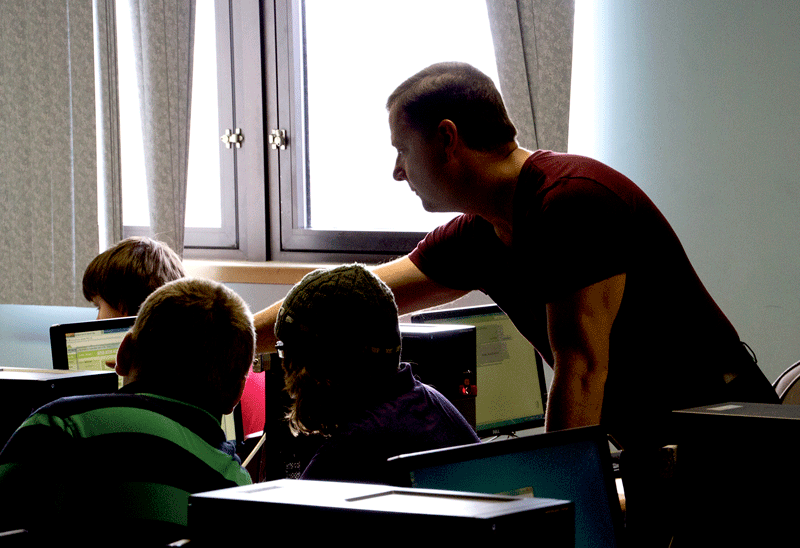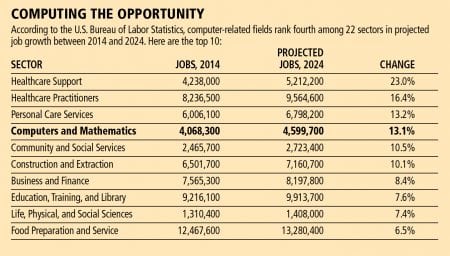
Women Remain Underrepresented in IT — but Why?
Missed Connections

Robin Saunders says the job opportunities and flexible working options in the IT field make it an ideal landing spot for talented women.
Despite the fact that women comprise roughly half the workforce and the majority of college enrollment, the world of computers and information technology remains a largely man’s world, with women accounting for just over one-quarter of all professionals. Many reasons have been posited for this disparity, but most industry leaders agree that opportunity abounds for talented women willing to, as one local professor put it, “just jump in.”
The numbers aren’t surprising anymore, but they’re still striking.
According to the National Science Foundation, though women make up roughly half of the college-educated workforce — and well over half of current college students — they comprise just 25% of the nation’s workforce in ‘computer and mathematical sciences,’ the name the Bureau of Labor Statistics gives to the broad industry most people call IT, or information technology.
“When I graduated in the mid-’80s, it wasn’t quite 50-50, but there were more women for sure,” said Brian Candido, associate professor and program chair of Computer Information Technologies at Springfield Technical Community College, noting that the field is slowly diversifying racially, but not along gender lines. “What’s interesting is that colleges are 60-40 female, and the projections are 70-30 in the next five years — but not in IT. It still tends to be white males. We’re seeing more Latinos, which is good, but not as many women as I’d like to see.”
Robin Saunders, director of Graduate Programs in Communications and Information Management at Bay Path University, agrees — even from her perspective at a women’s university.
“It is absolutely a problem,” she said. “If you look at the studies done by Google, women represent less than a third of the people in information-technology fields. They partly attribute that to women not being encouraged in high school to get into computer science. They’re told it’s difficult, it’s boring, it’s technology. When I was in my graduate cybersecurity degree program, I was the only woman. It can be pretty intimidating.”
And that’s unfortunate, she said, considering the opportunity that exists in IT, citing projections that, by 2020, some 1.4 million computer-science jobs will need to be filled, making IT one of the fastest-growing industries in the U.S. (see table below). It’s that growth, she said — and increased efforts to engage women at a younger age about those opportunities — that will start to shift the trend, she added.
“Many of those jobs will be filled by women,” she said. “It’s a perfect place for women to be; these are jobs that can be done full-time, part-time, or in an entrepreneurial way. If women are looking for something that’s flexible, it’s a perfect field to be in, and the jobs are expanding exponentially.”
In short, now is the time for young women — and older career changers, for that matter — to consider a field that, despite lingering stereotypes, is as promising and diverse as any. And that message is being delivered in myriad ways.
“The Girl Scouts just developed a coding badge, which is wonderful and something that teaches girls computer science is not just for your quintessential computer geeks, guys sitting in the basement with headsets,” Saunders said. “Women say that’s not what they want to be. But they don’t understand what the definition of information technology is. It’s such a broad field.”
She cited examples of applied computer science, which uses computers to examine and solve problems in a variety of industries, from healthcare to finance to precision machining. Meanwhile, professionals in her own specialty, cybersecurity, are increasingly in demand in virtually all types of businesses.
“Women are so sought after when they graduate,” she added. “Employers are looking for women to fill those positions. There’s a big push to equalize the genders in business, so if you’re a women with a degree in computer science, it pretty much guarantees a job.”
Breaking the Code
If that’s the case, why that nagging 25% statistic?
ISACA, a nonprofit that specializes in developing knowledge and practices for the IT industry, recently tried to get at the answer from within, surveying women who currently work in IT about the greatest barriers they face.
The top five were lack of mentors (48%), lack of female role models in the field (42%), gender bias in the workplace (39%), unequal growth opportunities compared to men (36%), and unequal pay for the same skills (35%).
“Women are vastly underrepresented in the global technology workforce. This is not only a societal concern, but also a workforce problem, given the critical shortage of skilled technology professionals faced by many enterprises,” said Jo Stewart-Rattray, board director of ISACA. “The survey findings reinforce that there is much work left to be done. By providing more opportunities, including career-advancement programs, we can make long-overdue progress in ensuring that women are more equitably represented in the technology workforce.”
When asked about opportunities for professional growth, 75% of respondents said their employer lacks a gender leadership development program. Additionally, 80% report that their supervisors are male, and just 8% report never experiencing gender bias in the workplace.
One big takeaway, Stewart-Rattray said, is that women hunger to learn and benefit from the presence of other women in technology.

Brian Candido says STCC’s female enrollment in computer programs has mirrored national statistics, but the college is taking steps to increase it.
Saunders said it needs to start early, with clubs as young as middle school that get girls together to talk about technology and coding, and organizations like Girls That Code. And those networks need to extend into adulthood; a good example is Saunders’ own participation with the Women in Cybersecurity network, whose national conference she addressed two years ago.
“Women love mentoring and love networking, and they’re good at it. That’s the way to get them interested.”
Candido agreed that outreach and engagement should begin long before college if the industry wants to turn around its drastic general imbalance.
“We see four or five female graduates a year, and the ones that do finish do quite well,” he told BusinessWest. “The companies we partner with, MassMutual, Baystate Health, they want diversity. They want employees that reflect the community at large.”
Everyone uses technology and social media, and some of that is spurring interest in what’s making it tick, what’s behind the software, what makes it happen.”
STCC has made efforts to create that diversity on its own campus, such as the STEM Starter Academy, which financially supports first-year students entering the STEM fields, with a particular emphasis on women and students of color; this year’s cohort is 50% female. Then there’s Candido’s mobile-programming course he teaches at Commerce High School, a project-based course that has teenagers developing apps in an effort to pique their interest in an IT career. Of the 18 current students, six are female.
“Everyone uses technology and social media, and some of that is spurring interest in what’s making it tick, what’s behind the software, what makes it happen,” he said, adding that there’s a meritocracy in the tech world that rewards what someone can do, not necessarily what demographic they are. “Some of these opportunities now, they don’t even meet with people; they work remotely over the Internet, develop apps and deploy them, or work on networks. We’re seeing that people can work everywhere and work virtually.”
Because they’re working in virtually every industry, Saunders noted, Bay Path’s applied computer science degree is especially attractive to students who see technology as a way to create tools and apps that solve real-world problems, rather than as an end in itself. Meanwhile, the school’s master’s degree in applied data science prepares them for an economy that is expected to need an influx of 190,000 big-data experts by 2018.
Meanwhile, Bay Path’s Center of Excellence for Women in STEM provides a number of supportive resources for students pursuing IT and other STEM-related degrees, including professional-development, mentorship, and networking opportunities; guest speakers, workshops, and forums; and honors programs.
It’s enough to make women want to take the plunge into IT, she said, and that’s the point.
“Just jump in, I say,” she told BusinessWest. “You know this industry is going to explode. So get in and see how it feels.”
Shift Key
While colleges are doing their part, the industry itself bears some responsibility for creating a more female-friendly culture, Stewart-Rattray argued.
“There also is much that enterprises can do, such as ensuring they are offering equitable pay for men and women and providing flexible working arrangements,” she noted. “Having ‘keep in touch’ days when women are on maternity leave, in addition to encouraging professional-development opportunities such as webinars and online courses, are other worthwhile ways to ensure that women remain connected to the organization while on leave.”
After all, she added, cultivating a more diverse work culture just makes economic sense.
“In addition to promoting a more just society, enterprises have bottom-line motivation to hire and promote women,” she said, citing research from the Peterson Institute for International Economics suggesting that organizations with at least 30% female leaders add up to 6% to their profit margin, on average. “This does not surprise me. The women I have worked with are highly motivated, focused, and encouraging of their colleagues. They are as knowledgeable — if not moreso — than their male counterparts.”
Saunders knows that to be true, and she tells prospective students as much.
“My recommendation is just to be fearless. We all had to start somewhere. The only problem is, the future doesn’t wait for anybody. If you don’t jump off the diving board, you’re going to be left behind.”
Joseph Bednar can be reached at [email protected]






